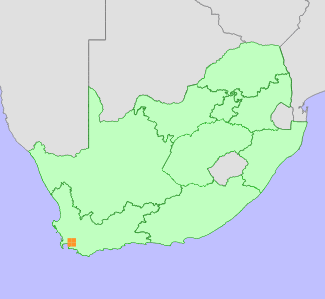|
Scientific Name | Serruria kraussii Meisn. |
Higher Classification | Dicotyledons |
Family | PROTEACEAE |
Common Names | Snowball Spiderhead (e) |
National Status |
Status and Criteria | Vulnerable B1ab(i,ii,iii,iv,v)+2ab(i,ii,iii,iv,v) |
Assessment Date | 2020/06/29 |
Assessor(s) | A.G. Rebelo, H. Mtshali & L. von Staden |
Justification | Serruria kraussii has a very restricted distribution range, with an extent of occurrence (EOO) of 205-207 km², and an area of occupancy (AOO) of 120 km². Between seven and 10 remaining locations continue to decline, due to habitat loss and competition from alien invasive plants. It is therefore assessed as Vulnerable under criterion B. |
Distribution |
Endemism | South African endemic |
Provincial distribution | Western Cape |
Range | This species is endemic to the Western Cape Province, South Africa, where it occurs along the Hottentots-Holland Mountains, from Jonkershoek to Sir Lowry's Pass. |
Habitat and Ecology |
Major system | Terrestrial |
Major habitats | Kogelberg Sandstone Fynbos, Cape Winelands Shale Fynbos, Boland Granite Fynbos |
Description | It grows in granite and sandstone soils, 140-1200 m. Mature individuals are killed by fires, and only seeds survive. Seeds are released after ripening, and dispersed by ants to their underground nests, where they are protected from predation and fire. It is pollinated by insects. |
Threats |
| This species' habitat in Jonkershoek and Helderberg has been lost through extensive past habitat transformation to pine plantations, fruit orchards and vineyards. Timber plantations are no longer expanding, but sporadic expansion of fruit orchards continues. Plantations are a major source of alien invasive plants that spread into adjacent native vegetation, and outcompete local species. Other alien invasive plants occurring throughout this species include hakeas and acacias and are causing ongoing habitat degradation. |
Population |
Serruria kraussii is known from 22 subpopulations, with several hundred plants. Subpopulations are threatened by alien invasive species, and outside nature reserves by ongoing agricultural expansion.
|
Population trend | Decreasing |
Conservation |
| This species is conserved within the Jonkershoek and Helderberg nature reserves. |
Assessment History |
Taxon assessed |
Status and Criteria |
Citation/Red List version | | Serruria kraussii Meisn. | VU A2c; B1ab(i,ii,iii,iv,v)+2ab(i,ii,iii,iv,v) | Raimondo et al. (2009) | | Serruria kraussii Meisn. | Rare | Hilton-Taylor (1996) | | Serruria kraussii Meisn. | Rare | Hall et al. (1980) | |
Bibliography |
Goldblatt, P. and Manning, J.C. 2000. Cape Plants: A conspectus of the Cape Flora of South Africa. Strelitzia 9. National Botanical Institute, Cape Town.
Hall, A.V., De Winter, M., De Winter, B. and Van Oosterhout, S.A.M. 1980. Threatened plants of southern Africa. South African National Scienctific Programmes Report 45. CSIR, Pretoria.
Hilton-Taylor, C. 1996. Red data list of southern African plants. Strelitzia 4. South African National Botanical Institute, Pretoria.
Manning, J.C. and Goldblatt, P. 2012. Plants of the Greater Cape Floristic Region 1: The Core Cape Flora. Strelitzia 29. South African National Biodiversity Institute, Pretoria.
Raimondo, D., von Staden, L., Foden, W., Victor, J.E., Helme, N.A., Turner, R.C., Kamundi, D.A. and Manyama, P.A. 2009. Red List of South African Plants. Strelitzia 25. South African National Biodiversity Institute, Pretoria.
Rebelo, T. 2001. Sasol Proteas: A field guide to the proteas of southern Africa. (2nd ed.). Fernwood Press, Vlaeberg, Cape Town.
|
Citation |
| Rebelo, A.G., Mtshali, H. & von Staden, L. 2020. Serruria kraussii Meisn. National Assessment: Red List of South African Plants version . Accessed on 2025/05/31 |
 Comment on this assessment
Comment on this assessment

